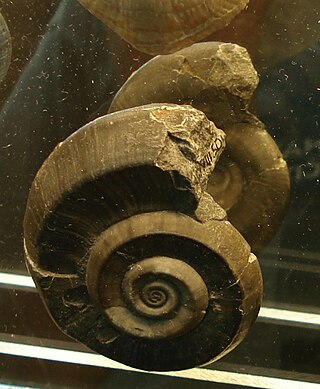Strepsodiscus is an extinct genus of very primitive fossil snail-like molluscs from the early part of the Late Cambrian of North America. The coiled, slightly asymmetrical shells are about 3 cm in height. It is not known whether these are shells of gastropods or monoplacophorans, which are more primitive mollusks.

The Bellerophontida is a taxonomic order of extinct marine mollusks that are found in the fossil record from the Lower Cambrian to the Lower Triassic. They are considered by some experts to be primitive sea snails with primarily symmetrically coiled shells, marine gastropod mollusks.

The Bellerophontidae are an extinct family of specialized globose bellerophontids, Paleozoic and early Triassic mollusks of the class Gastropoda.

Latouchella is an extinct genus of marine invertebrate animal, that is considered to be a mollusk and which may be a sea snail, a gastropod. It is a helcionellid from the Tommotian epoch of what is now Siberia. Its tightly coiled, spiral shell contains a number of low "walls" running up the front surface of the interior; these would have directed water currents within its shell. Between these walls are a series of furrows, parallel to the shell's aperture, giving casts of the internal structure the appearance of a railway line, with sleepers tying together paired rails that run towards the apex of the shell.

Helcionelloida is an extinct group of ancient molluscs. These are the oldest known conchiferan molluscs, that is, they had a mineralised shell. Some members of this class were mistaken for Monoplacophorans. The class was erected by Peel in 1991.

Euomphalidae is an extinct family of Paleozoic to early Mesozoic marine molluscs which may be gastropods with anisostrophically coiled shells . The shells show a selenizone.
Khairkhaniidae is an extinct family of Paleozoic fossil molluscs of uncertain position. They are thought to belong to either the Gastropoda or Monoplacophora. They possess planispiral coiled shells with a columnar microstructure.
†Archaeopragidae is an extinct family of paleozoic molluscs of uncertain position.
Bucanellidae is an extinct family of Paleozoic molluscs of uncertain position, belonging either to Gastropoda (snails) or Monoplacophora. The family lived from the upper Cambrian to middle Permian and the shells are characterized by a relatively small median sinus in the upper margin of the aperture, and collabral (transverse) or spiral (longitudinal) threads covering the shell. The shells are planispirally coiled rather than trochospirally with a spire as is the case with most shelled gastropods.
Tropidodiscidae is an extinct family of Paleozoic fossil molluscs with isostrophically coiled shells. They are of uncertain position taxonomically, in other words it is not known whether they were s.

Tremanotidae is an extinct family of Paleozoic fossil molluscs with isostrophically coiled shells. They occupy an uncertain position taxonomically: it is not known whether they were (gastropods or monoplacophorans.
Bucaniidae is an extinct family of Paleozoic molluscs of uncertain position possibly being either gastropods or monoplacophorans in the superfamily Bellerophontoidea. The family lived from the Lower Ordovician to the Devonian and have shells in which the apertural margins tend to flare. Most genera have a slit and selenizone, others some modification of this feature.
Euphemitidae is an extinct family of Paleozoic fossil molluscs of uncertain position. They have isostrophically coiled shells and may be either Gastropoda sea (snail)s, or Monoplacophora.
Pterothecidae is an extinct family of Paleozoic molluscs of uncertain position, either Gastropoda or Monoplacophora, with isostrophically coiled shells.
Sinuitidae is an extinct family of Paleozoic molluscs of uncertain position. They had isostrophically coiled shells.

Macluritidae is an extinct family of relatively large, Lower Ordovician to Devonian, macluritacean gastropods(?), hypserstrophically coiled, that is dextral while appearing sinistral, of which the genus Maclurites is arch-typical. The base of their shells is flat or gently protruding while the upper side is generally concave.
Omphalocirridae is an extinct family of Paleozoic molluscs (gastropods?) with anisostrophically coiled shells of uncertain position (Gastropoda?).
Helicotomidae is an extinct family of Paleozoic molluscs (gastropods?) with anisostrophically coiled shells of uncertain position (Gastropoda?).

Lesueurillidae is an extinct family of paleozoic molluscs (gastropods?) with anisostrophically coiled shells of uncertain position (Gastropoda?).

Euomphaloidea, originally Euomphalacea, is an extinct superfamily of marine molluscs that lived from the Early Ordovician to the Late Cretaceous, included in the Gastropoda but speculated as instead perhaps Monoplacophora.




